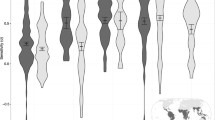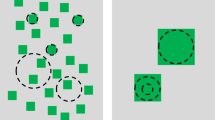Abstract
Current ecological theory predicts an allometric relation between the number of species with restricted range size (endemics) and area (the endemics–area relation EAR), a pattern similar to the common species–area relation (SAR). Using SARs and EARs we can estimate species loss after habitat loss. A comparison of the predictive power of both approaches (using a patch occupancy model and data from European butterflies) revealed that the EAR approach is less reliable than the SAR. Contrary to current theory it appeared that EARs are relations in their own right that describe spatial distributions of endemic species. They do not simply follow from the underlying SAR. The implications of these results for the applicability of SARs and EARs in biodiversity forecasting are discussed.
Similar content being viewed by others
References
H. Andrén (1994) ArticleTitleEffects of habitat fragmentation on birds and mammals in landscapes with different proportions of suitable habitat: a review Oikos 71 355–366
Andersen M., Thoruhill A. and Koopowitz H. 1997. Tropical forest disruption and stochastic biodiversity loss. In: Laurance W.F. and Bierregard R.O. (eds), Tropical Forest Remnants. University of Chicago Press, pp. 281–291.
O. Arrhenius (1921) ArticleTitleSpecies and area J. Ecol. 9 95–99
A. Balmford A. Long (1994) ArticleTitleAvian endemism and forest loss Nature 372 623–624 Occurrence Handle10.1038/372623a0 Occurrence Handle1:CAS:528:DyaK2MXislansb0%3D
P.A. Burrough (1983) ArticleTitleMultiscale sources of spatial variation in soil I. The application of fractal concepts to nested levels of soil variation J. Soil Sci. 34 577–597
R.K. Colwell J.A. Coddington (1994) ArticleTitleEstimating terrestrial biodiversity through extrapolation Philos. Trans. R. Soc. Lond. B 345 101–118 Occurrence Handle1:STN:280:ByqD283ls1I%3D
E.F. Connor E.D. McCoy (1979) ArticleTitleThe statistics and biology of the species–area relationship Am. Nat. 113 791–833 Occurrence Handle10.1086/283438
M.J. Crawley J.E. Harral (2001) ArticleTitleScale dependence in plant biodiversity Science 291 864–868 Occurrence Handle11157164 Occurrence Handle10.1126/science.291.5505.864 Occurrence Handle1:CAS:528:DC%2BD3MXpslKqtw%3D%3D
D.M. Golden T.O Crist (1999) ArticleTitleExperimental effects of habitat fragmentation on old-field canopy insects: community, guild and species responses Oecologia 118 371–380 Occurrence Handle10.1007/s004420050738
D. Griffiths (1992) ArticleTitleSizeabundanceand energy use in communities J. Anim. Ecol. 61 307–315
Hanski I. 1999. Metapopulation Ecology. University Press Oxford.
Harte J. 2000. Scaling and self-similarity in species distributions: implications for extinction, species richness, abundance, and range. In: Brown J.H., West G.B. and Enquist B.J. (eds), Scaling in Biology: Patterns and Processes, Causes and Consequences. Oxford University Press, pp. 325–342.
J. Harte A.P. Kinzig (1997) ArticleTitleOn the implications of species–area relationships for endemismspatial turnoverand food web patterns Oikos 80 417–427
J. Harte A.P. Kinzig J. Green (1999) ArticleTitleSelf-similarity in the distribution and abundance of species Science 284 334–336 Occurrence Handle10195901 Occurrence Handle10.1126/science.284.5412.334 Occurrence Handle1:CAS:528:DyaK1MXitlOgtLY%3D
Hastings H.M. and Sugihara G. 1993. Fractals – A User’s Guide for the Natural Sciences. Oxford University Press.
A.P. Kinzig J. Harte (2000) ArticleTitleImplications of endemics–area relationships for estimates of species extinction Ecology 81 3305–3311
A. Kruess T. Tscharnke (2000) ArticleTitleSpecies richness and parasitism in a fragmented landscape: experiments and field studies with insects on Vicia sepium Oecologia 122 129–137
W.A. Leitner M.L. Rosenzweig (1997) ArticleTitleNested species-area curves and stochastic sampling: a new theory Oikos 79 503–512
J.J. Lennon W.E. Kunin S. Hartley (2002) ArticleTitleFractal species distributions do not produce power-law species–area relationships Oikos 97 378–386 Occurrence Handle10.1034/j.1600-0706.2002.970308.x
M.V. Lomolino (2000) ArticleTitleEcologist’s most general, yet protean pattern: the species–area relationship J. Biogeogr. 27 17–26
M.V. Lomolino M.D. Weiser (2001) ArticleTitleTowards a more general species–area relationship: diversity on all islands, great and small J. Biogeogr. 28 431–445 Occurrence Handle10.1046/j.1365-2699.2001.00550.x
R.D. Maddux K. Athreya (1999) ArticleTitleOn the distribution and abundance of species Science 286 1647a Occurrence Handle10.1126/science.286.5445.1647a
May R.M., Lawton J.H. and Stork N.E. 1995. Assessing extinction rates. In: Lawton J.H. and May R.M. (eds), Extinction Rates. University Press Oxford, pp. 1–24.
M. Ney-Nifle M. Mangel (1999) ArticleTitleSpecies–area curves based on geographic range and occupancy J. Theoret. Biol. 196 327–342
M. Ney-Nifle M. Mangel (2000) ArticleTitleHabitat loss and changes in the species–area relationship Conserv. Biol. 14 893–898 Occurrence Handle10.1046/j.1523-1739.2000.98163.x
D.L. Pearson F. Cassola (1992) ArticleTitleWorld-wide species richness patterns of tiger beetles (Coeleoptera: Cicindelidae): indicator taxon for biodiversity and conservation studies Conserv. Biol. 6 376–391 Occurrence Handle10.1046/j.1523-1739.1992.06030376.x
S.L. Pimm (1998) Extinction W.J. Sutherland (Eds) Conservation Science and Action Blackwell Oxford 28–38
S.L. Pimm R.A. Askins (1995) ArticleTitleForest losses predict bird extinction in eastern North America Proc. Natl. Acad. Sci. USA 92 9343–9347 Occurrence Handle11607581 Occurrence Handle1:CAS:528:DyaK2MXosVWltbc%3D
J.B. Plotkin M.D. Potts D.W. Yu S. Bunyavejchewin R. Condit R. Foster S. Hubbell J. LaFranckie N. Manokaran L.H. Seng R. Sukarmar M.A. Nowak P.S. Ashton (2000) ArticleTitlePredicting species diversity in tropical forests Proc. Natl. Acad. Sci. USA 97 10850–10854 Occurrence Handle11005859 Occurrence Handle1:CAS:528:DC%2BD3cXnt1ahs78%3D
Rosenzweig M.L. 1995. Species Diversity in Space and Time. University Press Cambridge.
M.L. Rosenzweig (2001) ArticleTitleLoss of speciation rate will impoverish future diversity Proc. Natl. Acad. Sci. USA 98 5404–5410 Occurrence Handle11344286 Occurrence Handle10.1073/pnas.101092798 Occurrence Handle1:CAS:528:DC%2BD3MXjs1Wgtbg%3D
K.S. Summerville T.O. Crist (2003) ArticleTitleDeterminants of Lepidopteran community composition and species diversity in eastern deciduous forests: roles of season, ecoregion and patch size Oikos 100 134–148 Occurrence Handle10.1034/j.1600-0706.2003.11992.x
Swaay C. and van Warren M. 1999. Red Data Book of European Butterflies (Rhopalocera). Nature and Environment No. 99, Strasbourg.
M. Tokeshi (1996) ArticleTitlePower fraction: a new explanation of relative abundance patterns in species-rich assemblages Oikos 75 543–550
Ulrich W. 2002a. Patch Occupancy – a FORTRAN program for the study of species spatial distributions. www.uni.torun.pl/˜ulrichw
Ulrich W. 2002b. RAD – a FORTRAN program for the study of relative abundance distributions. www.uni.torun.pl/˜ulrichw
W Ulrich (2004a) ArticleTitle PatchOccupancy – a FORTRAN program for modeling patterns of species spatial distributions Ecol. Quest. 4 13–19
Ulrich W. 2004b. Fitting stochastic models of relative abundance distributions to species abundance data. Ecol. Quest. 4, (in press).
W. Ulrich J. Buszko (2003a) ArticleTitleSelf-similarity and the species–area relation of Polish butterflies Basic Appl. Ecol. 4 263–270 Occurrence Handle10.1078/1439-1791-00139
W. Ulrich J. Buszko (2003b) ArticleTitleThe species–area relationship of butterflies in Europe: the simulation of extinction processes reveals different patterns between Northern and Southern Europe Ecography 26 365–374 Occurrence Handle10.1034/j.1600-0587.2003.03441.x
Ulrich W. and Buszko J. 2004a. Detecting biodiversity hotspots using species–area and endemics–area relationships: the case of butterflies. Biodiv. Conserv., (in press).
W. Ulrich J. Buszko (2004b) ArticleTitleHabitat reduction and patterns of species loss Basic Appl. Ecol. 5 231–240 Occurrence Handle10.1016/j.baae.2004.04.002
J.A. Veech (2000) ArticleTitleChoice of species-area function affects identification of hotspots Conserv. Biol. 14 140–147 Occurrence Handle10.1046/j.1523-1739.2000.99064.x
E.O. Wilson (1992) The Diversity of Life Norton New York
S. Zschokke C. Dolt H.-P. Rusterholz P. Oggler B. Braschler G.H. Thommen E. Lüdin A. Erhardt B. Baur (2000) ArticleTitleShort term responses of plants and invertebrates to experimental small-scale grassland fragmentation Oecologia 125 559–572 Occurrence Handle10.1007/s004420000483
Author information
Authors and Affiliations
Corresponding author
Rights and permissions
About this article
Cite this article
Ulrich, W. Predicting Species Numbers Using Species–Area and Endemics–Area Relations. Biodivers Conserv 14, 3351–3362 (2005). https://doi.org/10.1007/s10531-004-9543-3
Received:
Accepted:
Issue Date:
DOI: https://doi.org/10.1007/s10531-004-9543-3




